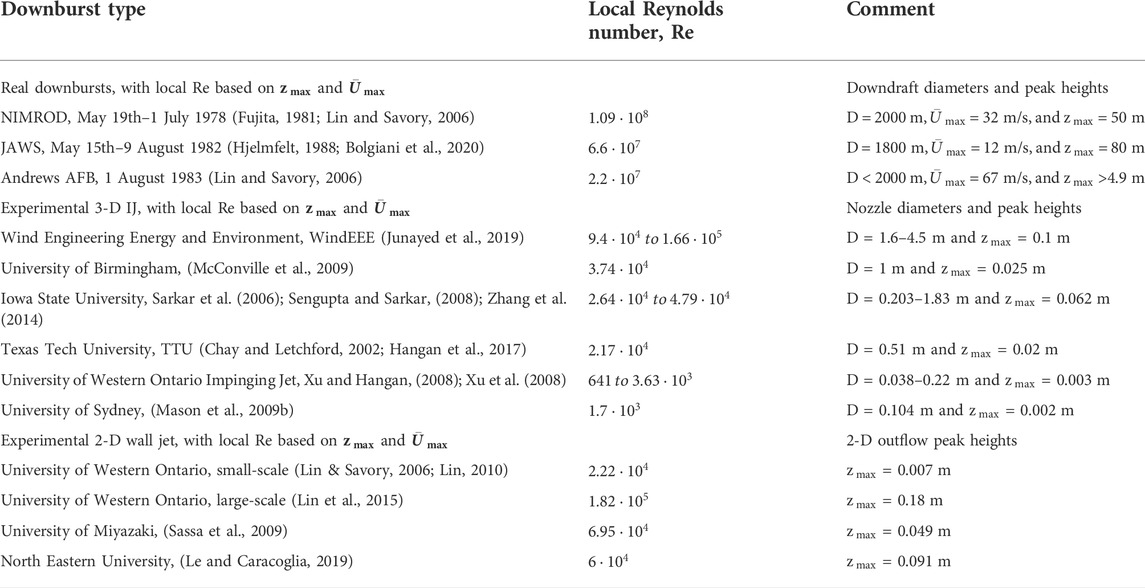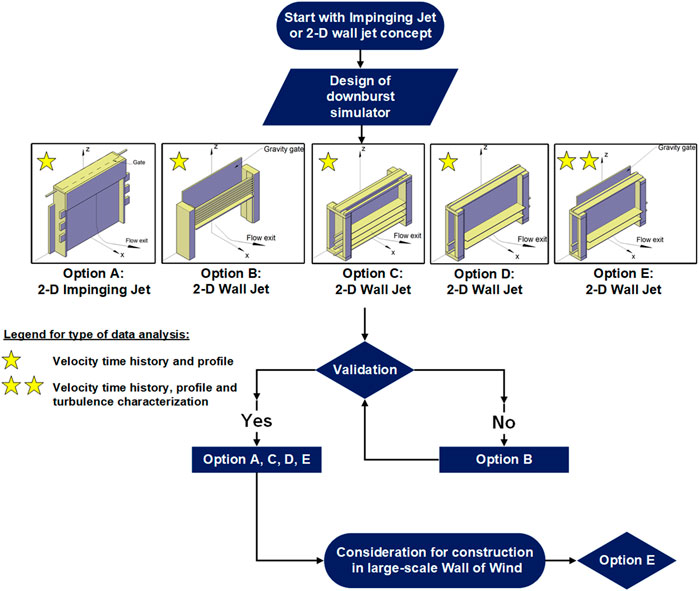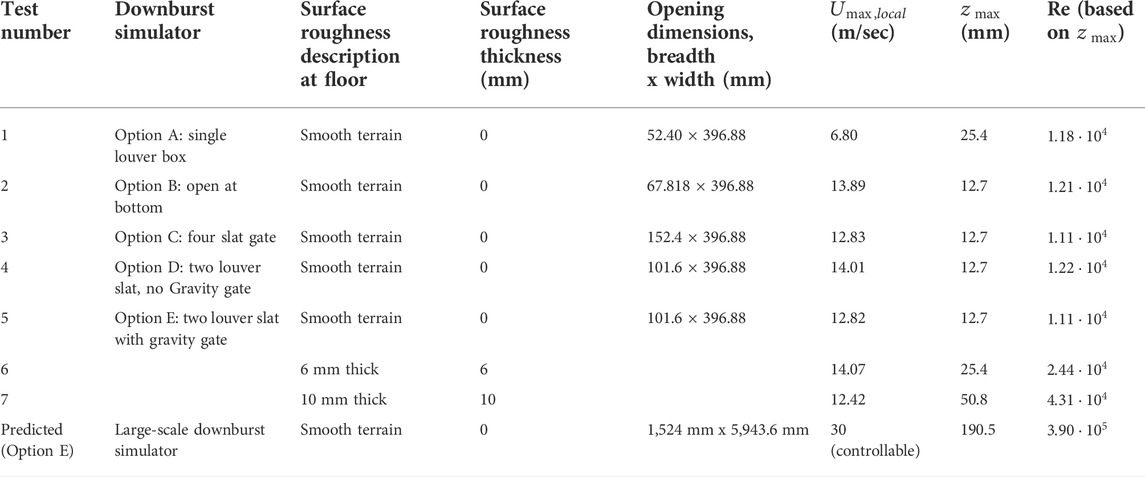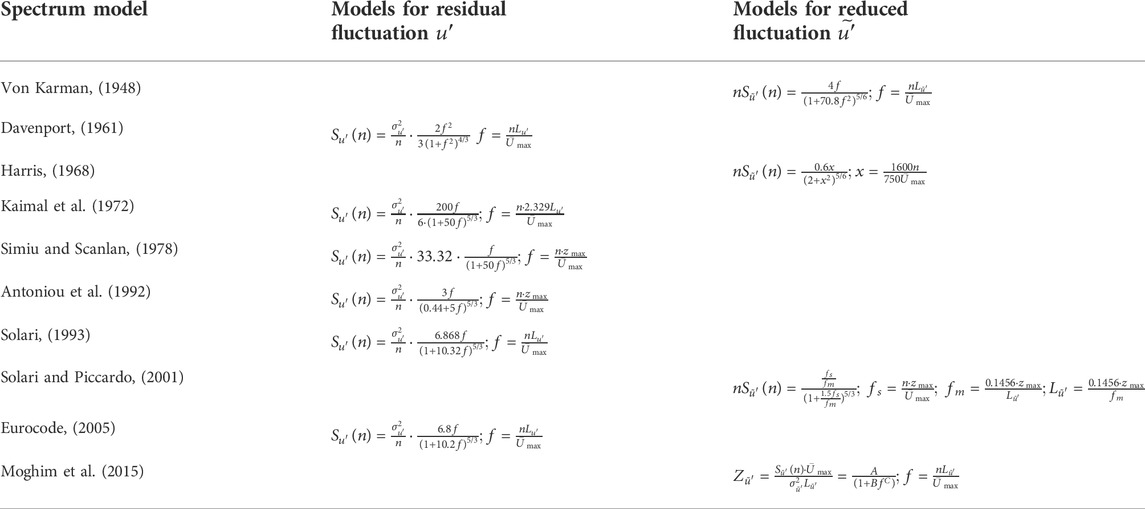Examination of different wall jet and impinging jet concepts to produce large-scale downburst outflow
- 1Florida International University, Miami, FL, United States
- 2Extreme Events Institute, Florida International University, Miami, FL, United States
Thunderstorm downburst winds are a major cause of severe damage to buildings and other infrastructure. The initiative of the NSF-NHERI Wall of Wind (WOW) Experimental Facility to design and develop a downburst simulator was established to open new horizons for multi-hazard engineering research by extending the current capabilities of the facility to enable the simulation of non-synoptic winds. Five different downburst simulator designs have been tested in the 1:15 small-scale replica of the WOW to identify the optimal design. The design concepts tested herein considered both the 2-D impinging jet and the 2-D wall jet simulation methods. The basic design methodology consists of transforming the available atmospheric boundary layer (ABL) wind simulator into downburst winds by adding an external modification device to the exit of the flow management box. A flow characterization comparison among the five contending downburst simulators, along with comparisons to real downbursts and previous literature findings, has been conducted. The study on the effect of surface roughness length on the height of the peak wind velocity showed that the implementation of a 2-D plane wall jet enables large-scale outflows (higher peak velocity height) with high Reynold numbers, which is advantageous in terms of reducing scaling effects. In general, the current research work showed that four downburst simulation methods were suitable for adoption; however, only one downburst simulator was recommended based on the feasibility of construction in the facility. The chosen downburst simulator consisted of a two louver slat system near the bottom, with a blockage at the top. This configuration enables producing a large rolling vortex passing through the testing section, which would serve adequately in the further study of turbulent flow characterization and testing of larger scale test models.
Introduction
Thunderstorm downburst winds are stochastic, non-stationary, non-Gaussian, localized, highly turbulent, and extreme weather phenomena that produce high intensity winds. Downbursts descend as a powerful jet of cold downdraft wind as a result of atmospheric convection, impinge vertically downwards into the ground, and diverge a ring vortex that curls up and include an outflow in all radial directions (Fujita, 1985, 1990). This outflow has the form of a 3-D radial wall jet, creating severe horizontal wind velocities that lead to substantial damage to surrounding structures. Downbursts are characterized by their strong, highly spatiotemporal variable wind shear stresses near the ground (Zhu and Etkin, 1985), which impose a significant threat to low, medium, and high buildings and long span structures such as transmission lines and suspension bridges. The horizontal maximum wind velocities, which typically exceed conventional design wind speeds, can reach up to 75 m/s (Letchford et al., 2002), occurring at heights between 30 and 100 m above the ground (Holmes, 1999; Hjelmfelt, 2002; Lin & Savory, 2006) and with relatively short durations lasting from 2 to 30 min (Selvam and Holmes, 1992; Letchford et al., 2002; Lin and Savory, 2006). The sizes of downbursts can be classified as microbursts (
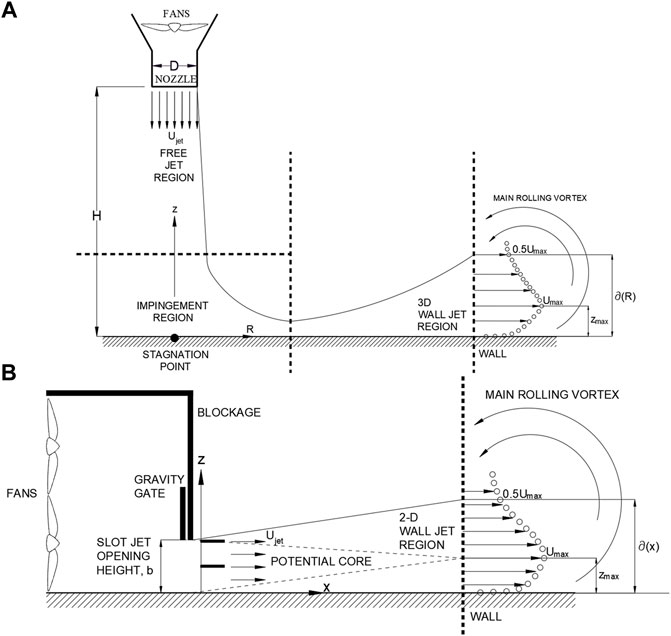
FIGURE 1. (A) Impingement jet model, credit: Sengupta and Sarkar, 2008. (B) 2-D Wall jet test model, credit: Lin and Savory, 2006; 2012.
The typical procedure for the IJ is to maintain a fixed height to diameter ratio H/D, where H is the distance from the nozzle tip to the orthogonal wall surface, and D is the nozzle diameter that represents the jet diameter of the flow before impingement into the orthogonal wall surface. The recommended value for H/D was found to be larger than one, in order to be able to develop a complete main ring vortex (Kim et al., 2007) so that a significant large 3-D outflow size with a maximum horizontal velocity is obtained downstream from the stagnation point. The outflow is dependent upon the lower values of Re but start to become independent at
IJ tests are widely used among wind engineers because these tests provide a closer approximation to real downbursts. It is noted from Table 1 that the largest IJ is the WindEEE facility with a Re value three orders of magnitude smaller than the average Re value from a real downburst like the NIMROD full-scale event. The smaller Re values of experimental tests demonstrate a mismatch of the kinematic similarities between full-scale and experimentally simulated downburst events. The main motivation of the current article is to simulate and characterize a reliable downburst outflow of significant size at the National Science Foundation (NSF)-designated Experimental Facility (EF) Wall of Wind (WOW) to further extend the current capabilities of the national facility. The study aims to identify and optimize the design concept of a large-scale downburst simulator that is suitable for structural aerodynamic and aeroelastic testing at larger scales. Also, to investigate how the peak height
Experimental set-up
Wall of Wind Experimental Facility
The NSF-Natural Hazard Engineering Research Infrastructure (NHERI) Wall of Wind (WOW) Experimental Facility (EF) located in Miami, Florida is a large-scale, conventional, and boundary layer open jet wind testing facility that is capable of testing small- to full-scale destructive and non-destructive models of various types of civil engineering structures. It consists of an arched plenum, contraction section, and a flow management box that allows an open jet flow to be discharged downstream into a testing section area. An airflow of 135.9 m3/s is achieved by using twelve propeller fans arranged in two rows by six columns arc pattern with an individual fan diameter of 1.83 m and operated by respective fan motors that deliver a total power of 6,264 kW altogether. The range of wind velocities are initialized from a minimum of 4.47 m/s to a maximum of 71.53 m/s, hence reaching Saffir–Simpson category five hurricane wind velocities. It also includes a set of vertical spires that help produce ABL characteristics in the exiting flow and consists of a mechanically operated roughness elements that allows the modification of various surface roughness conditions. Figure 2A shows the intake and Figure 2Bshows the exit of the WOW facility. The produced ABL wind flow field is equal to the size of the flow management box cross-sectional area of 6.1 m wide by 4.3 m high and passes through a 4.9 m diameter turntable center (where the test models are fixed at the base) located at 6 m from the flow management box outlet. The overall longitudinal fetch of the wind flow field exiting the flow management box outlet and passing through the turntable section is a total of 11.63 m long. More details on design, dimensions, and construction of the full-scale WOW can be found in the following articles by Chowdhury et al. (2017), Chowdhury et al. (2018). Strategic downstream horizontal locations away from the wind jet initiation (i.e., flow management outlet) are analyzed in this study including the turntable front (TTF), turntable center (TTC), and turntable back (TTB).
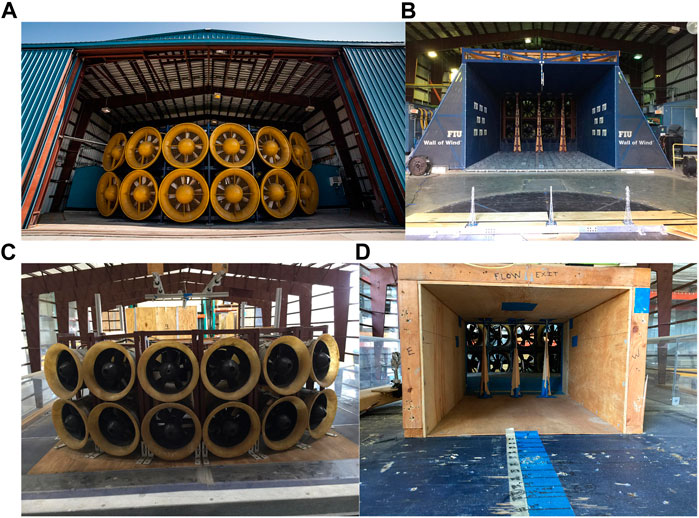
FIGURE 2. (A) Full-scale WOW intake; (B) full-scale WOW flow management box; (C) small-scale 1:15 WOW intake; and (D) small-scale 1:15 WOW flow management box.
Small-scale Wall of Wind
The WOW EF is equipped with a 1:15 replica of the flow simulator (called small-scale WOW thereafter), which contains identical components of the full-scale WOW flow management box including the spires, the arched plenum, and testing section. The small-scale WOW serves to carry out physical testing for new preliminary designs and concepts to assess the wind flow behavior before implementation at higher cost at the full-scale facility. The small-scale WOW is built out of wood and is run by a system of twelve electronic operating propeller fans of 127 mm diameter each. A piece of control software runs the twelve fans velocity and operation duration. The current study involves the tryouts of five different downburst simulators in the small-scale WOW so that one of these can be selected and be built in the large-scale WOW. In addition to a smooth plywood surface in the testing section floor of the small-scale WOW (assumed to be open terrain in this study), two different roughness with varying thicknesses were added to the test section floor to account for the effect of increasing surface roughness length
Downburst simulator designs
As mentioned earlier, five different downburst simulator options were designed and tested in the small-scale WOW. One 2-D IJ simulator and four 2-D wall jet simulators were considered and tested in the small-scale WOW to simulate downburst flows. Figure 3 shows schematics of all five downburst simulator options. For Option A, as seen in Figure 3A, a blockage is installed in front of the flow management box, completely shutting the WOW flow field and redirecting the wind upward. The compartment with controllable louvers stores a volume of air of 1,282 cm3. When a downburst is desired, the venting louvers will be closed, and a second set of louvers will open, allowing wind to flow downward on the turntable side of the blockage wall, creating a 2-D impinging jet that collides with the ground and forms a downburst-like vortex. Controlling the duration of time for opening/closing the louvers would allow for control of the downburst event duration. After the IJ takes place, a single main rolling vortex is formed traveling across the testing section downstream. The three regions conforming the IJ, the free jet, the impingement and outflow region are maintained with this type of downburst simulator. This type of simulator is one of a kind as it enables converting a classic wind tunnel into a 2-D IJ like downburst simulator without the need of blowers and nozzles positioned vertically and oriented downward. Option B, shown in Figure 3B, consisted of an opening near the ground and a fixed set of venting louvers placed at an angle of
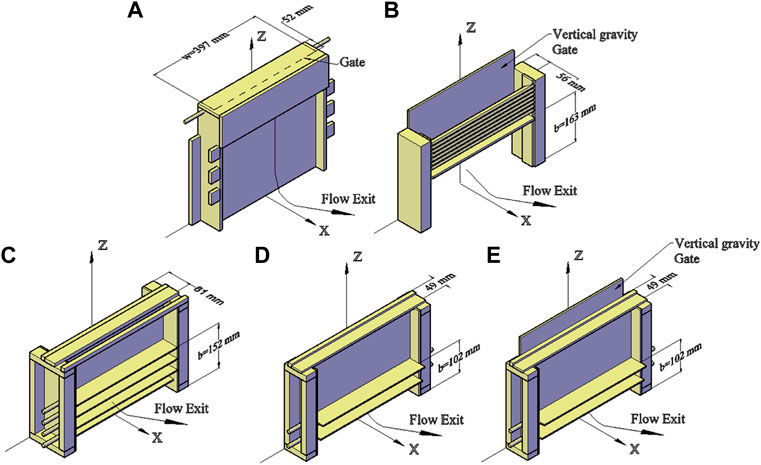
FIGURE 3. Downburst simulator options: (A) Option A, (B) Option B, (C) Option C, (D) Option D, and (E) Option (E)
Addition of roughness
The floor of the testing section consists of a plywood surface, representing a smooth terrain condition. In addition, two surface roughness of thickness 6 and 10 mm with a plastic and artificial grass texture were implemented to determine the variation in the outflow under the influence of surface roughness length
A schematic summary layout of the downburst simulator design process and selection is shown in Figure 4 to facilitate the work presented herein.
Instrumentation and test plan
Two types of measurement probes were utilized to measure the wind velocities at different heights and horizontal distances in the test section. The two data acquisition systems consisted of a Scanivalve™ DSA 3217 with a sampling frequency of 500 Hz and a Turbulent Flow Instrumentation™ Series 100 Cobra probes with a sampling frequency of 2,500 Hz were used as shown in Figure 5A. The use of two different acquisition systems served as a validity cross-check between these two when repeated test runs were performed. Both acquisition systems complemented each other by providing an overall analysis of the downburst outflow development at strategic locations of the turntable as shown in Figure 5B. The Scanivalve™ DSA 3217 differential pressure measurements were obtained with sixteen pitot tubes made from brass hollow pipes of 0.36 mm internal diameter and were positioned in a vertical rake spaced at uniform height increments of 12.7 mm above the floor level reaching to a maximum height of 203.2 mm. The differential pressure or the dynamic wind pressure was obtained using the following Eq. 1:
where
Discussion of results
Decomposition of downburst wind velocities
Downburst winds are non-stationary and localized in time with a sudden intense 2-D wall jet constituting a primary ring vortex growth. Downburst instantaneous total wind velocities are typically decomposed by a classical moving average filter into their moving mean and fluctuating wind velocities as suggested by Choi and Hidayat (2002), Chen and Letchford (2004), and Holmes et al. (2008), Solari et al. (2015). The total instantaneous wind velocity of a downburst at any height
where
where
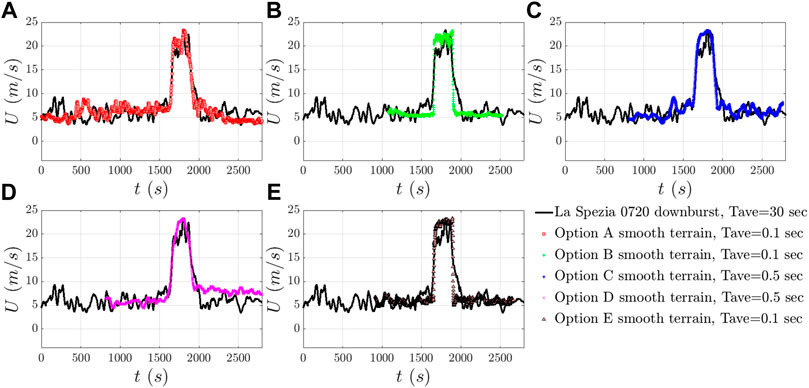
FIGURE 6. Velocity time history comparison among all downburst simulations for options a, b, c, d, e and a real downburst event Termed La Spezia 0720; courtesy of Professor Giovanni Solari and “Wind and Ports” and “Wind, Ports, and Sea” Campaigns.
In an attempt to validate whether the downburst main characteristics are obtained in the experimental simulations, the wind velocity time histories were scaled to match a full-scale downburst in time and velocity using Eqs 4, 5, respectively. The experimental results were superimposed to match the baseline and peak height mid-points of a real full-scale downburst, which is one of many recorded through the “Wind and Ports” (Solari et al., 2012) and “Wind, Ports, and Sea” (Repetto et al., 2018) ongoing campaign projects that have captured downburst outflows with high resolution anemometers.
where
Velocity profiles
The vertical velocity profile of the horizontal velocities with a typical “nose shape” is one of the primary downburst characteristics that differ significantly from the common atmospheric boundary layer (ABL) profile. Figure 7 shows the vertical profiles of the normalized moving mean horizontal velocities for all five tested simulators. Figure 7A shows the instantaneous velocity profiles measured at the time instant of the local maximum velocity at the TTC, and Figure 7B shows the envelope velocity profiles, which are defined as the local maximum velocities recorded across all times for each height. It can be seen from both figures that the shape of the nose is observed, with option A providing the largest peak height

FIGURE 7. Vertical velocity profiles of normalized horizontal wind velocities for: (A) instantaneous wind velocities at TTC; (B) envelope wind velocities at TTC; (C) envelope of Option E at different horizontal distances; (D) envelope of Option D and Option E at TTC for different roughness; and (E) horizontal velocity profile validation.
It is always recommended to maximize the simulated Re so that the flow becomes independent of the nozzle and jet initiation conditions and that the outflow simulation represents a proper downburst with a considerable surface friction and a wall jet thickness
From Table 2, it can be seen that Option A provides the higher peak height in smooth terrain over the other downburst simulator options. The range of Re obtained in the downburst simulators discussed herein vary between the smallest
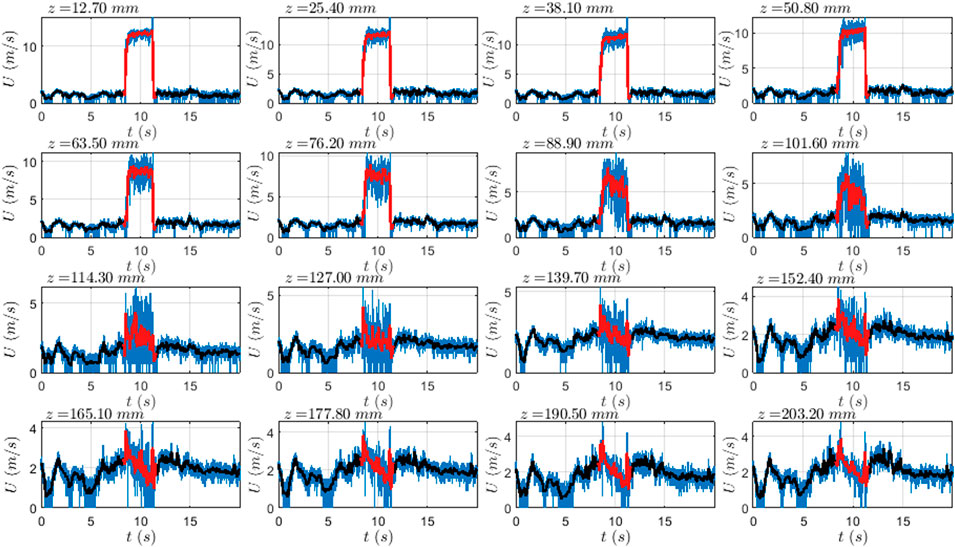
FIGURE 8. Downburst time history recorded at various heights using the 16 pitot tubes at the TTC using downburst simulator Option E in smooth terrain.
Figure 9A shows the temporal evolution of the instantaneous vertical velocity profile of the normalized mean horizontal wind velocities at TTC for downburst simulator Option E. Figure 9B shows the smoke visualization of the main rolling vortex provided by Option E. The passage of the main rolling vortex is marked by the presence of the nose shaped vertical velocity profile at specific time instants. At 10 s, the nose shape profile is observed. By 12 s, the downburst flow has already vanished at the TTC, and the wind velocities are back to almost zero as the gravity gate (GG) has shut down the flow.
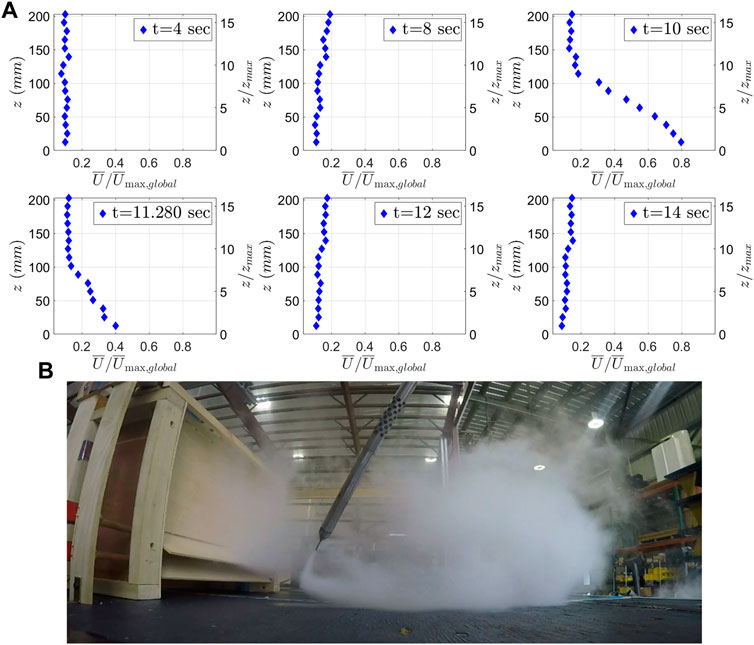
FIGURE 9. (A) Downburst evolution of the instantaneous vertical velocity profile of the mean horizontal wind velocities at TTC for simulator Option E. (B) Smoke flow visualization of main rolling vortex for Option E.
Figure 10 shows a snapshot of the growth of the wall jet thickness
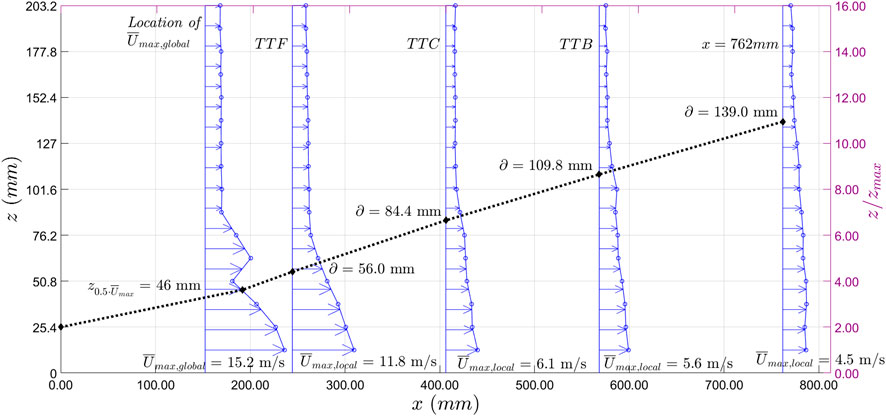
FIGURE 10. Downburst wall jet growth at the time of global peak velocity at various downstream distances for Option E.
Turbulence intensity
Turbulence, by definition, is the state of flow in which the inertial motion of turbulent eddies makes a dominant role in energy and momentum transfer (Makita, 1991). A great difficulty exists in obtaining these statistical quantities in downburst applications due to their non-stationary and transient properties. Thus, in the case of downbursts, it is difficult to quantify a turbulent flow structure in the same manner as it has been performed before for stationary processes such as atmospheric boundary layer (ABL) winds. The analysis herein evaluates the turbulence intensity,
where
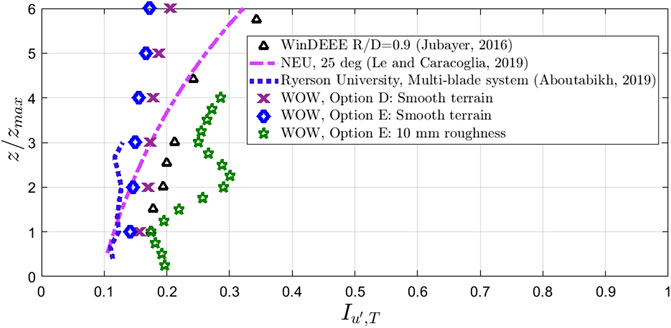
FIGURE 11. Turbulence intensity vertical profiles for downburst simulator Options D and E at the TTC for smooth terrain and 10-mm thick surface roughness.
The trend of the turbulence intensity profiles of Option D and Option E in Figure 11 agrees well with previous results from Jubayer et al., 2016 at the WindEEE dome IJ simulation, the multi-blade small-scale testing with louver slats tilted at 25° angle by Le and Caracoglia (2019) at North Eastern University (NEU) and the multi-blade 2-D wall jet by Aboutabikh et al. (2019). The magnitude of these values is related to the denominator selected in Eq. 6. Some authors like Wang and Kareem, 2004 and McCullough et al., 2014 select the denominator to be a mean of the moving mean value of the velocity and other authors like Elawady et al., 2017 prefer to select the maximum value of the moving mean velocity. This is one subjective decision of many that exist in the case of downbursts analysis. Another example is the selection of an adequate duration T. Several researchers select the start time of the downburst event before the ramp-up starts and sometime after the ramp-down to be the duration T. Others select the duration T to be at the start of the ramp-up and end of the ramp-down. The statistical characteristics within the peak duration of the event change significantly and differ from a stationary process. A ramp-up, a plateau zone, and a ramp-down contain their own duration and specific statistical characteristic. Thus, for downburst analysis, considering a combination of different statistical characteristics in one whole process is somewhat controversial. Usually the common trend for turbulence intensity profiles, both for synoptic and non-synoptic winds, tend to decrease as the height increases (Chay, 2001; Lombardo et al., 2018). In the case of downburst events in urban Beijing analyzed by Zhang et al. (2019), it can be observed that the turbulence intensity profiles have a variable “zigzag” trend with height, especially near the ground. This is not the case in the 2-D wall jet cases tested herein or the ones presented in the literature by Jubayer et al. (2016) or Le and Caracoglia (2019), where turbulence intensity increases with height. This situation may be due to the fact that these are tested in a limited space with side walls affecting the results from forming boundary layers. Also, the turbulent intensity values started to be measured at a height
Power spectral density
Turbulence fluctuations can be visualized as the superposition of eddies or gusts of different sizes and frequencies. The integral length scale is an estimate of the average size of those eddies in the flow constituting turbulence. The difference between ABL and downburst turbulence characteristics is that the horizontal integral length scales are typically smaller in the case of downbursts because of their smaller scales, localized nature, and proximity to the ground (Solari et al., 2015). Three methods are commonly used by researchers in wind engineering to determine the integral length scales (Teunissen, 1980). These are the direct integration method, the exponential fit method and the power spectra fit method. Usually, the first and second methods derive the integral length scales from correlation functions. The third method can be used in two ways: first by applying a fast Fourier transform (FFT) in the residual fluctuation components
The preferred method for providing best results of the integral length scale among all methods presented for stationary systems is the exponential fit. In the case of downburst, given the difference in statistical quantities found in the ramp-up, plateau, and ramp-down, these methods may require modifications so that they can be utilized adequately. A common modification was discussed by Solari et al. (2015), where the PSD of a reduced fluctuation
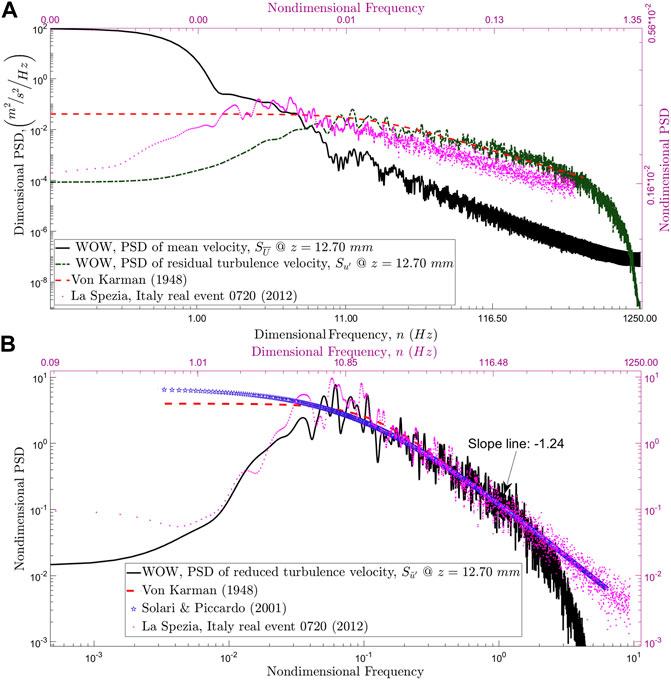
FIGURE 12. Power spectral density (PSD) of the (A) residual and (B) reduced fluctuations for downburst simulators option E at the TTC.
The intersection between the PSD of the residual turbulence and PSD of the moving mean reflects a shedding frequency,
Concluding remarks
Only four downburst simulators out of five designed and tested herein provide a suitable downburst outflow. By adding one of these downburst simulators to a conventional wind tunnel test section, the synoptic winds can be converted into non-stationary winds. Option A offers the design of redirecting the horizontal flow from the wind tunnel facility to a 2-D impinging jet coming vertically downward, hitting the ground and creating the main rolling vortex with a higher peak height
Data availability statement
The raw data supporting the conclusion of this article will be made available by the authors, without undue reservation.
Author contributions
The manuscript was prepared by AM and supervised by AE. KV assisted with the experimental procedures, data analysis and collection. DC and AC reviewed the manuscript and helped enhance it.
Funding
These tests were conducted at the NHERI Wall of Wind Experimental Facility (NSF CMMI #1520853 and #2037899). The authors of this manuscript wish to acknowledge the financial support offered by NSF (Award No. 1762968) to perform these tests.
Acknowledgments
The authors of this report wish to thank the WOW personnel, especially Jimmy Erwin, for their continuous assistance and support.
Conflict of interest
The authors declare that the research was conducted in the absence of any commercial or financial relationships that could be construed as a potential conflict of interest.
Publisher’s note
All claims expressed in this article are solely those of the authors and do not necessarily represent those of their affiliated organizations, or those of the publisher, the editors, and the reviewers. Any product that may be evaluated in this article, or claim that may be made by its manufacturer, is not guaranteed or endorsed by the publisher.
References
Abd-Elaal, E.-S., Mills, J. E., and Ma, X. (2018). Numerical simulation of downburst wind flow over real topography. J. Wind Eng. Ind. Aerodyn. 172, 85–95.
Abdelwahab, M., Ghazal, T., and Aboshosha, H. (2022). Designing a multi-purpose wind tunnel suitable for limited spaces. Results Eng. 14, 100458. doi:10.1016/j.rineng.2022.100458
Aboshosha, H., Bitsuamlak, G., and El Damatty, A. (2015). Turbulence characterization of downbursts using LES. J. Wind Eng. Industrial Aerodynamics 136, 44–61. doi:10.1016/j.jweia.2014.10.020
Aboshosha, H. (2014). Response of transmission line conductors under downburst wind. London, ON: The University of Western Ontario.
Aboutabikh, M., Ghazal, T., Chen, J., Elgamal, S., and Aboshosha, H. (2019). Designing a blade-system to generate downburst outflows at boundary layer wind tunnel. J. Wind Eng. Industrial Aerodynamics 186, 169–191. doi:10.1016/j.jweia.2019.01.005
Alahyari, A., and Longmire, E. K. (1994). Particle image velocimetry in a variable density flow: Application to a dynamically evolving microburst. Exp. Fluids 17, 434–440. doi:10.1007/bf01877047
Antoniou, I., Asimakopoulos, D., Fragoulis, A., Kotronaros, A., Lalas, D., and Panourgias, I. (1992). Turbulence measurements on top of a steep hill. J. Wind Eng. Industrial Aerodynamics 39, 343–355. doi:10.1016/0167-6105(92)90558-r
Asano, K., Iida, Y., and Uematsu, Y. (2019). Laboratory study of wind loads on a low-rise building in a downburst using a moving pulsed jet simulator and their comparison with other types of simulators. J. Wind Eng. Industrial Aerodynamics 184, 313–320. doi:10.1016/j.jweia.2018.11.034
Bolgiani, P., Santos-Muñoz, D., Fernández-González, S., Sastre, M., Valero, F., and Martin, M. L. (2020). Microburst detection with the WRF model: Effective resolution and forecasting indices. JGR. Atmos. 125, e2020JD032883. doi:10.1029/2020jd032883
Butler, K., and Kareem, A. (2007). “Physical and numerical modeling of downburst generated gust fronts,” in Proceedings of the 12th international conference on wind engineering (Cairns, Australia: IEEE).
Cao, S., Nishi, A., Kikugawa, H., and Matsuda, Y. (2002). Reproduction of wind velocity history in a multiple fan wind tunnel. J. Wind Eng. Industrial Aerodynamics 90, 1719–1729. doi:10.1016/s0167-6105(02)00282-9
Chay, M. T., and Letchford, C. W. (2002). Pressure distributions on a cube in a simulated thunderstorm downburst—Part A: Stationary downburst observations. J. Wind Eng. Industrial Aerodynamics 90, 711–732. doi:10.1016/s0167-6105(02)00158-7
Chay, M. T. (2001). Physical modeling of thunderstorm downbursts for wind engineering applications. Lubbock, TX: Texas Tech University.
Chen, L., and Letchford, C. W. (2004). A deterministic–stochastic hybrid model of downbursts and its impact on a cantilevered structure. Eng. Struct. 26, 619–629. doi:10.1016/j.engstruct.2003.12.009
Choi, E. C. C., and Hidayat, F. A. (2002). Gust factors for thunderstorm and non-thunderstorm winds. J. Wind Eng. Industrial Aerodynamics 90, 1683–1696. doi:10.1016/s0167-6105(02)00279-9
Chowdhury, A. G., Vutukuru, K. S., and Moravej, M. (2018). Full-and large-scale experimentation using the wall of wind to mitigate wind loading and rain impacts on buildings and infrastructure systems. Available at: https://www.academia.edu/43153499/Full_and_Large_Scale_Experimentation_Using_the_Wall_of_Wind_to_Mitigate_Wind_Loading_and_Rain_Impacts_on_Buildings_and_Infrastructure_Systems.
Chowdhury, A., Zisis, I., Irwin, P., Bitsuamlak, G., Pinelli, J. P., Hajra, B., et al. (2017). Large-scale experimentation using the 12-fan wall of wind to assess and mitigate hurricane wind and rain impacts on buildings and infrastructure systems. J. Struct. Eng. 143, 4017053. doi:10.1061/(asce)st.1943-541x.0001785
Davenport, A. G. (1961). The spectrum of horizontal gustiness near the ground in high winds. Q. J. R. Meteorol. Soc. 87, 194–211. doi:10.1002/qj.49708737208
Elawady, A., Aboshosha, H., El Damatty, A., Bitsuamlak, G., Hangan, H., and Elatar, A. (2017). Aero-elastic testing of multi-spanned transmission line subjected to downbursts. J. Wind Eng. Industrial Aerodynamics 169, 194–216. doi:10.1016/j.jweia.2017.07.010
Eurocode, B. (2005). Eurocode 1: Actions on structures–part1-4: General actions-wind actions; BS EN 1991-1-4: 2005. London: Br. Stand. Institution.
Fujita, T. (1990). Downbursts: Meteorological features and wind field characteristics. J. Wind Eng. Industrial Aerodynamics 36, 75–86. doi:10.1016/0167-6105(90)90294-m
Fujita, T. T. (1986). DFW (Dallas-Ft. Worth) microburst on august 2, 1985. Chicago, IL, United States: Chicago Univ.
Fujita, T. T. (1981). Tornadoes and downbursts in the context of generalized planetary scales. J. Atmos. Sci. 38, 1511–1534. doi:10.1175/1520-0469(1981)038<1511:taditc>2.0.co;2
Hangan, H., Kim, J.-D., and Xu, Z. (2004). “The simulation of downbursts and its challenges,” in Structures 2004: Building on the past, securing the future (Springer), 1–8.
Hangan, H., Refan, M., Jubayer, C., Romanic, D., Parvu, D., LoTufo, J., et al. (2017). Novel techniques in wind engineering. J. Wind Eng. Industrial Aerodynamics 171, 12–33. doi:10.1016/j.jweia.2017.09.010
Harris, R. I. (1968). Measurements of wind structure at heights up to 598 ft above ground level. England, United Kingdom: Electrical Research Association.
Hjelmfelt, M. R. (1988). Structure and life cycle of microburst outflows observed in Colorado. J. Appl. Meteor. 27, 900–927. doi:10.1175/1520-0450(1988)027<0900:salcom>2.0.co;2
Hjelmfelt, M. R. (2002). Structure and life cycle of microburst outflows observed in Colorado. J. Appl. Meteor. 27, 900–927. doi:10.1175/1520-0450(1988)027<0900:salcom>2.0.co;2
Holmes, J. D., Hangan, H. M., Schroeder, J. L., Letchford, C. W., and Orwig, K. D. (2008). A forensic study of the Lubbock-Reese downdraft of 2002. Wind Struct. 11, 137–152. doi:10.12989/was.2008.11.2.137
Holmes, J. D. (1999). “Modeling of extreme thunderstorm winds for wind loading of structures and risk assessment,” inWind Engineering into the 21st Century, Proceedings of the 10th International Conference on Wind Engineering, Copenhagen, Denmark, 1409–1415.
Holmes, J. D., and Oliver, S. E. (2000). An empirical model of a downburst. Eng. Struct. 22, 1167–1172. doi:10.1016/s0141-0296(99)00058-9
Holmes, J. D. (1992). “Physical modelling of thunderstorm downdrafts by wind tunnel jet,” in 2nd AWES workshop (Victoria, Australia: Monash University), 29–32.
Hoogewind, K. A., Baldwin, M. E., and Trapp, R. J. (2017). The impact of climate change on hazardous convective weather in the United States: Insight from high-resolution dynamical downscaling. J. Clim. 30, 10081–10100. doi:10.1175/jcli-d-16-0885.1
Huang, G. (2015). Application of proper orthogonal decomposition in fast Fourier transform—Assisted multivariate nonstationary process simulation. J. Eng. Mech. 141, 4015015. doi:10.1061/(asce)em.1943-7889.0000923
Huang, G., Zheng, H., Xu, Y., and Li, Y. (2015). Spectrum models for nonstationary extreme winds. J. Struct. Eng. 141, 4015010. doi:10.1061/(asce)st.1943-541x.0001257
Ivan, M. (1986). A ring-vortex downburst model for flight simulations. J. Aircr. 23, 232–236. doi:10.2514/3.45294
Jesson, M., Sterling, M., Letchford, C., and Haines, M. (2015). Aerodynamic forces on generic buildings subject to transient, downburst-type winds. J. Wind Eng. Industrial Aerodynamics 137, 58–68. doi:10.1016/j.jweia.2014.12.003
Jubayer, C., Elatar, A., and Hangan, H. (2016). “Pressure distributions on a low-rise building in a laboratory simulated downburst,” in Proceedings of the 8th international colloquium on bluff body aerodynamics and applications (Boston, Massachusetts, USA: IEEE).
Junayed, C., Jubayer, C., Parvu, D., Romanic, D., and Hangan, H. (2019). Flow field dynamics of large-scale experimentally produced downburst flows. J. Wind Eng. Industrial Aerodynamics 188, 61–79. doi:10.1016/j.jweia.2019.02.008
Kaimal, J. C., Wyngaard, J. C. J., Izumi, Y., and Coté, O. R. (1972). Spectral characteristics of surface-layer turbulence. Q. J. R. Meteorol. Soc. 98, 563–589. doi:10.1002/qj.49709841707
Kim, J., Hangan, H., and Eric Ho, T. C. (2007). Downburst versus boundary layer induced wind loads for tall buildings. Wind Struct. 10, 481–494. doi:10.12989/was.2007.10.5.481
Kim, J., and Hangan, H. (2007). Numerical simulations of impinging jets with application to downbursts. J. Wind Eng. Industrial Aerodynamics 95, 279–298. doi:10.1016/j.jweia.2006.07.002
Knowles, K., and Myszko, M. (1998). Turbulence measurements in radial wall-jets. Exp. Therm. Fluid Sci. 17, 71–78. doi:10.1016/s0894-1777(97)10051-6
Landreth, C. C., and Adrian, R. J. (1990). Impingement of a low Reynolds number turbulent circular jet onto a flat plate at normal incidence. Exp. Fluids 9, 74–84. doi:10.1007/bf00575338
Launder, B. E., and Rodi, W. (1983). The turbulent wall jet measurements and modeling. Annu. Rev. Fluid Mech. 15, 429–459. doi:10.1146/annurev.fl.15.010183.002241
Le, V., and Caracoglia, L. (2020). Experimental investigation on non-stationary wind loading effects generated with a multi-blade flow device. J. Fluids Struct. 96, 103049. doi:10.1016/j.jfluidstructs.2020.103049
Le, V., and Caracoglia, L. (2019). Generation and characterization of a non-stationary flow field in a small-scale wind tunnel using a multi-blade flow device. J. Wind Eng. Industrial Aerodynamics 186, 1–16. doi:10.1016/j.jweia.2018.12.017
Letchford, C., and Illidge, G. (1999). “Turbulence and topographic effects in simulated downrafts by wind tunnel jet,” in Proceedings of the 10th international conference on wind engineering, copenhagen, Denmark, 21-24 june 1999 (Netherlands: Rotterdam).
Letchford, C. W., and Chay, M. T. (2002). Pressure distributions on a cube in a simulated thunderstorm downburst. Part B: Moving downburst observations. J. Wind Eng. Industrial Aerodynamics 90, 733–753. doi:10.1016/s0167-6105(02)00163-0
Letchford, C. W., Mans, C., and Chay, M. T. (2002). Thunderstorms—Their importance in wind engineering (a case for the next generation wind tunnel). J. Wind Eng. Industrial Aerodynamics 90, 1415–1433. doi:10.1016/s0167-6105(02)00262-3
Li, C., Li, Q. S., Xiao, Y. Q., and Ou, J. P. (2012). A revised empirical model and CFD simulations for 3D axisymmetric steady-state flows of downbursts and impinging jets. J. Wind Eng. Industrial Aerodynamics 102, 48–60. doi:10.1016/j.jweia.2011.12.004
Lin, W. E., Orf, L. G., Savory, E., and Novacco, C. (2007). Proposed large-scale modelling of the transient features of a downburst outflow. Wind Struct. 10, 315–346. doi:10.12989/was.2007.10.4.315
Lin, W. E., and Savory, E. (2010). Physical modelling of a downdraft outflow with a slot jet. Wind Struct. an Int. J. 13, 385–412. doi:10.12989/was.2010.13.5.385
Lin, W. E. (2010). Validation of a novel downdraff outflow simulator. A slot jet wind tunnel Ottawa, Canada: Library and Archives.
Lin, W., Mara, T., and Savory, E. (2015). “Wind velocity profiles from a pulsed wall jet over ground roughness,” in 14th international conference on wind engineering (Brazil: Porto Alegre), 1–16.
Lin, W. E. (2012). Validation of a novel downdraft outflow simulator: A slot jet wind tunnel. Ottawa, ON: Library and Archives
Lin, W., and Savory, E. (2006). Large-scale quasi-steady modelling of a downburst outflow using a slot jet. Wind Struct. 9, 419–440. doi:10.12989/was.2006.9.6.419
Lombardo, F. T., Mason, M. S., and de Alba, A. Z. (2018). Investigation of a downburst loading event on a full-scale low-rise building. J. Wind Eng. Industrial Aerodynamics 182, 272–285. doi:10.1016/j.jweia.2018.09.020
Lundgren, T. S., Yao, J., and Mansour, N. N. (1992). Microburst modelling and scaling. J. Fluid Mech. 239, 461–488. doi:10.1017/s002211209200449x
Makita, H. (1991). Realization of a large-scale turbulence field in a small wind tunnel. Fluid Dyn. Res. 8, 53–64. doi:10.1016/0169-5983(91)90030-m
Mason, M. S., Fletcher, D. F., and Wood, G. S. (2010). Numerical simulation of idealised three-dimensional downburst wind fields. Eng. Struct. 32, 3558–3570. doi:10.1016/j.engstruct.2010.07.024
Mason, M. S., Letchford, C. W., and James, D. L. (2005). Pulsed wall jet simulation of a stationary thunderstorm downburst, Part A: Physical structure and flow field characterization. J. Wind Eng. Industrial Aerodynamics 93, 557–580. doi:10.1016/j.jweia.2005.05.006
Mason, M. S., Wood, G. S., and Fletcher, D. F. (2007). Impinging jet simulation of stationary downburst flow over topography. Wind Struct. 10, 437–462. doi:10.12989/was.2007.10.5.437
Mason, M. S., Wood, G. S., and Fletcher, D. F. (2009b). Influence of tilt and surface roughness on the outflow wind field of an impinging jet. Wind Struct. an Int. J. 12, 179–204. doi:10.12989/was.2009.12.3.179
Mason, M. S., Wood, G. S., and Fletcher, D. F. (2009a). Numerical simulation of downburst winds. J. Wind Eng. Industrial Aerodynamics 97, 523–539. doi:10.1016/j.jweia.2009.07.010
Matsumoto, M. (2007). “Drag forces on 2-D cylinders due to sudden increase of wind velocity,” in Proceedings of 12th international conference on wind engineering (IEEE), 1727–1734.
Matsumoto, M. (1984). Study on unsteady aerodynamic in unsteady wind flow. Kyoto, Japan: Kyoto University.
McConville, A. C., Sterling, M., and Baker, C. J. (2009). The physical simulation of thunderstorm downbursts using an impinging jet. Wind Struct. an Int. J. 12, 133–149. doi:10.12989/was.2009.12.2.133
McCullough, M., Kwon, D. K., Kareem, A., and Wang, L. (2014). Efficacy of averaging interval for nonstationary winds. J. Eng. Mech. 140, 1–19. doi:10.1061/(asce)em.1943-7889.0000641
Moghim, F., Xia, F. T., and Caracoglia, L. (2015). Experimental analysis of a stochastic model for estimating wind-borne compact debris trajectory in turbulent winds. J. Fluids Struct. 54, 900–924. doi:10.1016/j.jfluidstructs.2015.02.007
NOAA (2018). National oceanic and atmospheric administration, office for coastal management. Available at: https://www.noaa.gov/.
O’Donovan, T. S. (2005). Fluid flow and heat transfer of an impinging air jet.  Dublin, Ireland: Univ. Dublin.
Oseguera, R. M., and Bowles, R. L. (1988). A simple, analytic 3-dimensional downburst model based on boundary layer stagnation flow. Available at: https://ntrs.nasa.gov/api/citations/19880018674/downloads/19880018674.pdf.
Peng, L., Huang, G., Chen, X., and Kareem, A. (2017). Simulation of multivariate nonstationary random processes: Hybrid stochastic wave and proper orthogonal decomposition approach. J. Eng. Mech. 143, 4017064. doi:10.1061/(asce)em.1943-7889.0001273
Proctor, F. H. (1988). Numerical simulations of an isolated microburst. Part I: Dynamics and structure. J. Atmos. Sci. 45, 3137–3160. doi:10.1175/1520-0469(1988)045<3137:nsoaim>2.0.co;2
Proctor, F. H. (1989). Numerical simulations of an isolated microburst. Part II: Sensitivity experiments. J. Atmos. Sci. 46, 2143–2165. doi:10.1175/1520-0469(1989)046<2143:nsoaim>2.0.co;2
Repetto, M. P., Burlando, M., Solari, G., De Gaetano, P., Pizzo, M., and Tizzi, M. (2018). A web-based GIS platform for the safe management and risk assessment of complex structural and infrastructural systems exposed to wind. Adv. Eng. Softw. 117, 29–45. doi:10.1016/j.advengsoft.2017.03.002
Richter, A., Ruck, B., Mohr, S., and Kunz, M. (2018). Interaction of severe convective gusts with a street canyon. Urban Clim. 23, 71–90. doi:10.1016/j.uclim.2016.11.003
Romanic, D., Chowdhury, J., Jubayer, C., and Hangan, H. (2020). Investigation of the transient nature of thunderstorm winds from Europe, the United States, and Australia using a new method for detection of changepoints in wind speed records. Mon. Weather Rev. 148, 3747–3771.
Sarkar, P. P., Haan Fred, L, J., Balaramudu, V., and Sengupta, A. (2006). “Laboratory simulation of tornado and microburst to assess wind loads on buildings,” in Structures congress 2006: Structural engineering and public safety (Springer), 1–10.
Sassa, K., Inoue, A., and Miyagi, H. (2009). “Gust fronts generated in a multi-fan wind tunnel,” in The seventh asia-pacific conference on wind engineering (Taipei, Taiwan: IAWE).
Selvam, R. P., and Holmes, J. D. (1992). Numerical simulation of thunderstorm downdrafts. J. Wind Eng. Industrial Aerodynamics 44, 2817–2825. doi:10.1016/0167-6105(92)90076-m
Sengupta, A., and Sarkar, P. P. (2008). Experimental measurement and numerical simulation of an impinging jet with application to thunderstorm microburst winds. J. Wind Eng. Industrial Aerodynamics 96, 345–365. doi:10.1016/j.jweia.2007.09.001
Solari, G., Burlando, M., De Gaetano, P., and Repetto, M. P. (2015). Characteristics of thunderstorms relevant to the wind loading of structures. Wind Struct. 20, 763–791. doi:10.12989/was.2015.20.6.763
Solari, G. (1993). Gust buffeting. II: Dynamic alongwind response. J. Struct. Eng. 119, 383–398. doi:10.1061/(asce)0733-9445(1993)119:2(383)
Solari, G. (2018). “Mixed climatology, non-synoptic phenomena and downburst wind loading of structures,” in Conference of the Italian association for wind engineering (Springer), 17–31.
Solari, G., and Piccardo, G. (2001). Probabilistic 3-D turbulence modeling for gust buffeting of structures. Probabilistic Eng. Mech. 16, 73–86. doi:10.1016/s0266-8920(00)00010-2
Solari, G., Rainisio, D., and De Gaetano, P. (2017). Hybrid simulation of thunderstorm outflows and wind-excited response of structures. Meccanica 52, 3197–3220. doi:10.1007/s11012-017-0718-x
Solari, G., Repetto, M. P., Burlando, M., De Gaetano, P., Pizzo, M., Tizzi, M., et al. (2012). The wind forecast for safety management of port areas. J. Wind Eng. Industrial Aerodynamics 104, 266–277. doi:10.1016/j.jweia.2012.03.029
Solari, G. (2016). Thunderstorm response spectrum technique: Theory and applications. Eng. Struct. 108, 28–46. doi:10.1016/j.engstruct.2015.11.012
Teunissen, H. W. (1980). Structure of mean winds and turbulence in the planetary boundary layer over rural terrain. Bound. Layer. Meteorol. 19, 187–221. doi:10.1007/bf00117220
Van Hooff, T., Blocken, B., Defraeye, T., Carmeliet, J., and Van Heijst, G. J. F. (2012). PIV measurements of a plane wall jet in a confined space at transitional slot Reynolds numbers. Exp. Fluids 53, 499–517. doi:10.1007/s00348-012-1305-5
Verhoff, A. (1963). The two-dimensional, turbulent wall jet with and without an external free stream. Princeton, NJ: Princeton Univ NJ.
Vermeire, B. C., Orf, L. G., and Savory, E. (2011). A parametric study of downburst line near-surface outflows. J. Wind Eng. Industrial Aerodynamics 99, 226–238. doi:10.1016/j.jweia.2011.01.019
Vicroy, D. D. (1992). Assessment of microburst models for downdraft estimation. J. Aircr. 29, 1043–1048. doi:10.2514/3.46282
Von Karman, T. (1948). Progress in the statistical theory of turbulence. Proc. Natl. Acad. Sci. U. S. A. 34, 530–539. doi:10.1073/pnas.34.11.530
Walker, J. D. A., Smith, C. R., Cerra, A. W., and Doligalski, T. L. (1987). The impact of a vortex ring on a wall. J. Fluid Mech. 181, 99–140. doi:10.1017/s0022112087002027
Wang, L., and Kareem, A. (2004). “Modeling of non-stationary winds in gust-fronts,” in 9th ASCE specialty conference on probabilistic mechanics and structural reliability (American Society of Civil Engineers, Sandia National Laboratories), 1–6.
Wang, L., McCullough, M., and Kareem, A. (2013). A data-driven approach for simulation of full-scale downburst wind speeds. J. Wind Eng. Industrial Aerodynamics 123, 171–190. doi:10.1016/j.jweia.2013.08.010
Wang, L., McCullough, M., and Kareem, A. (2014). Modeling and simulation of nonstationary processes utilizing wavelet and Hilbert transforms. J. Eng. Mech. 140, 345–360. doi:10.1061/(asce)em.1943-7889.0000666
Wood, G. S., Kwok, K. C. S., Motteram, N. A., and Fletcher, D. F. (2001). Physical and numerical modelling of thunderstorm downbursts. J. Wind Eng. Industrial Aerodynamics 89, 535–552. doi:10.1016/s0167-6105(00)00090-8
Xu, Z., and Hangan, H. (2008). Scale, boundary and inlet condition effects on impinging jets. J. Wind Eng. Industrial Aerodynamics 96, 2383–2402. doi:10.1016/j.jweia.2008.04.002
Xu, Z., Hangan, H., and Yu, P. (2008). Analytical solutions for a family of Gaussian impinging jets. J. Appl. Mech. 75, 21019. doi:10.1115/1.2775502
Zhang, S., Yang, Q., Solari, G., Li, B., and Huang, G. (2019). Characteristics of thunderstorm outflows in Beijing urban area. J. Wind Eng. Industrial Aerodynamics 195, 104011. doi:10.1016/j.jweia.2019.104011
Zhang, Y., Hu, H., and Sarkar, P. P. (2014). Comparison of microburst-wind loads on low-rise structures of various geometric shapes. J. Wind Eng. Industrial Aerodynamics 133, 181–190. doi:10.1016/j.jweia.2014.06.012
Zhang, Y., Hu, H., and Sarkar, P. P. (2013a). Modeling of microburst outflows using impinging jet and cooling source approaches and their comparison. Eng. Struct. 56, 779–793. doi:10.1016/j.engstruct.2013.06.003
Zhang, Y., Sarkar, P., and Hu, H. (2013b). An experimental study of flow fields and wind loads on gable-roof building models in microburst-like wind. Exp. Fluids 54, 1511. doi:10.1007/s00348-013-1511-9
Zhao, Y., Cao, S., Tamura, Y., Duan, Z., and Ozono, S. (2009). “Simulation of downburst in a multiple fan wind tunnel and research on its load on high-rise structure by wind tunnel experiment,” in 2009 international conference on mechatronics and automation (IEEE), 4506–4511.
Keywords: downburst, thunderstorm, wind tunnel testing, wall of wind, non-synoptic wind
Citation: Mejia AD, Elawady A, Vutukuru KS, Chen D and Chowdhury AG (2022) Examination of different wall jet and impinging jet concepts to produce large-scale downburst outflow. Front. Built Environ. 8:980617. doi: 10.3389/fbuil.2022.980617
Received: 28 June 2022; Accepted: 16 August 2022;
Published: 27 September 2022.
Edited by:
Sukanta Basu, Delft University of Technology, NetherlandsReviewed by:
Haitham Aboshosha, Ryerson University, CanadaArnab Sarkar, Indian Institute of Technology (BHU), India
Copyright © 2022 Mejia, Elawady, Vutukuru, Chen and Chowdhury. This is an open-access article distributed under the terms of the Creative Commons Attribution License (CC BY). The use, distribution or reproduction in other forums is permitted, provided the original author(s) and the copyright owner(s) are credited and that the original publication in this journal is cited, in accordance with accepted academic practice. No use, distribution or reproduction is permitted which does not comply with these terms.
*Correspondence: Alvaro Danilo Mejia, ameji023@fiu.edu
†Present address:Krishna Sai Vutukuru, Thornton Tomasetti, Fort Lauderdale, FL, United States
 Alvaro Danilo Mejia
Alvaro Danilo Mejia Amal Elawady
Amal Elawady Krishna Sai Vutukuru
Krishna Sai Vutukuru Dejiang Chen
Dejiang Chen Arindam Gan Chowdhury
Arindam Gan Chowdhury